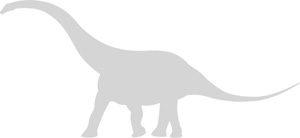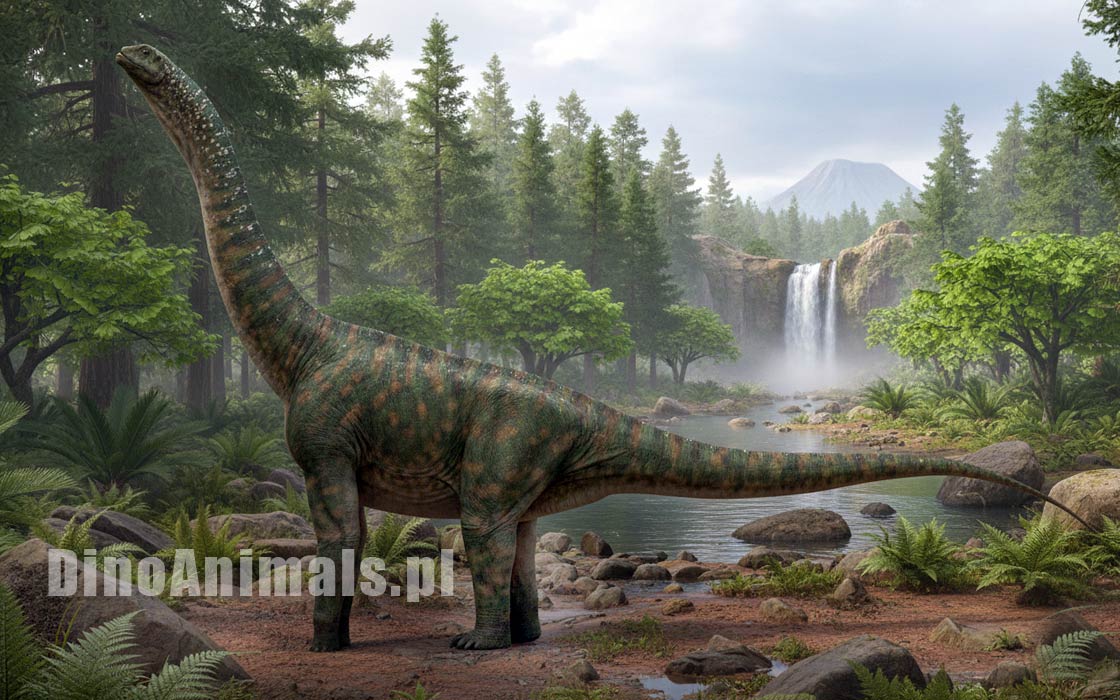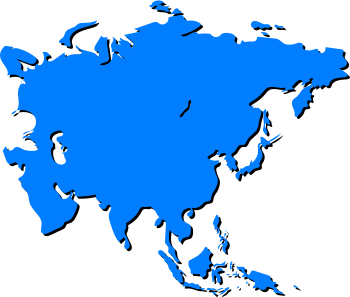Every month, 100,000 readers use the Dinosaur Database, but we receive no support from you. Developing and updating the database requires a lot of work. If you want it to remain open and be updated, please support us via the "Buy us a coffee" button available on every page or via the Support page.
Dinosaur: Jinchuanloong niedu

| Length*: | 10 m | 32.8 ft |
| Weight*: | 4.5 t | 9,921 lb |
*The largest known specimen
Description
Jinchuanloong niedu
Jinchuanloong niedu is a non-neosauropod eusauropod dinosaur from the Middle Jurassic (late Bathonian) of northwestern China. Discovered in the lower Xinhe Formation in Jinchang City, Gansu Province, it represents one of the most complete skulls known for non-neosauropod eusauropods and provides significant insight into early sauropod evolution in East Asia. The name Jinchuanloong combines the locality “Jinchuan” with “loong” (Mandarin for dragon), while niedu honors Jinchang (“nickel city”).
This species is particularly valuable due to its combination of primitive and derived features and its phylogenetic position near the base of Eusauropoda, making it a key taxon for understanding the evolutionary transition between basal sauropods and neosauropods.
Geographic Coordinates
Fossil site: Jinchuan District, Jinchang City, Gansu Province, China
Physical Characteristics
Jinchuanloong niedu is known from a partial but associated skeleton (holotype JCMF 0132), including:
- A nearly complete skull with mandible
- The five anteriormost cervical vertebrae
- 29 articulated middle to posterior caudal vertebrae
- Impressions of pelvic and sacral elements
The preserved skull is approximately 310 mm long (12.2 inches) and shows clear sutures and exceptional preservation. Based on the skull and vertebral dimensions, the estimated total body length is approximately 10 meters (32.8 feet). Weight: approximately 3,500–4,500 kg (7,700–9,900 lbs) (estimated based on comparisons with similar-sized eusauropods). The specimen is thought to represent a subadult, inferred from unfused bones and juvenile cranial features.
Key autapomorphies include:
- A small foramen at the base of the nasal process of the maxilla
- An aperture on the anterodorsal surface of the prefrontal
- A robust postorbital with specific proportions
- A unique contribution of the jugal to the infratemporal fenestra (22%)
The skull shows spoon-shaped teeth with wrinkled enamel and no denticles, consistent with basal eusauropod feeding adaptations.
Diet and Feeding Habits
As a sauropod, Jinchuanloong niedu was a herbivore. The spoon-shaped teeth and lack of denticles indicate a diet of soft to moderately tough plant material. Its jaw morphology suggests a simple cropping strategy without complex oral processing. The large external nares and nasal fenestrae likely played roles in thermoregulation and olfaction.
Habitat and Distribution
Jinchuanloong niedu inhabited the Chaoshui Basin in northwestern China during the late Bathonian (~167 million years ago). It lived in a humid, lacustrine-fluvial ecosystem characterized by:
- Interbedded sandstone and mudstone
- Shallow lakes and floodplains
- Rich assemblages of invertebrates and plants
This region was ecologically diverse and one of the few Middle Jurassic areas in China with abundant dinosaur fossils, complementing better-known faunas from Sichuan.
Behavior and Social Structure
While no direct evidence exists for behavior, its morphology suggests a typical eusauropod lifestyle: quadrupedal, slow-moving, with a long tail likely used for balance. The juvenile status of the holotype limits interpretation of adult traits such as possible display structures or advanced muscle attachments.
Discovery and Research
The holotype was discovered in 2017 by Dr. Li Daqing and his team in the Xinhe Formation near Jinchang. It was formally described in 2025 by Ning Li, Xiaoqin Zhang, and colleagues. The specimen represents the earliest known sauropod from Gansu Province and one of the best-preserved eusauropod skulls from China.
Phylogenetic analyses place Jinchuanloong within non-neosauropod Eusauropoda, as a sister taxon to the clade comprising Turiasauria and Neosauropoda, making it an important transitional form.
Significance and Notable Facts
- One of the most complete skulls of a non-neosauropod eusauropod
- Estimated at 10 m long, making it a medium-sized Middle Jurassic sauropod
- Adds to the diversity of East Asian sauropods, especially outside the Sichuan Basin
- First eusauropod described from the Xinhe Formation
- Skull features resemble those of Mamenchisaurus and Shunosaurus, but with key differences in cranial foramina and jugal structure
- Suggests early diversification of East Asian eusauropods before neosauropod dominance
Conclusion
Jinchuanloong niedu provides a rare glimpse into the cranial and postcranial anatomy of Middle Jurassic sauropods from East Asia. With a blend of primitive and derived traits, it occupies a critical position near the base of Eusauropoda and demonstrates that early sauropod evolution in China involved more complexity and diversity than previously thought. Its well-preserved skull, stratigraphic position, and distinctive features make it a cornerstone for future studies of Jurassic sauropod paleobiology.
Locations
Sources
Material: Nearly complete skull, mandible, five anterior cervical vertebrae, 29 articulated middle to posterior caudal vertebrae, impressions of pelvic elements, impressions of sacral vertebrae
References: Ning Li, Xiaoqin Zhang et al. (2025). "A new non-neosauropod eusauropod dinosaur from the Middle Jurassic of China". Scientific Reports




